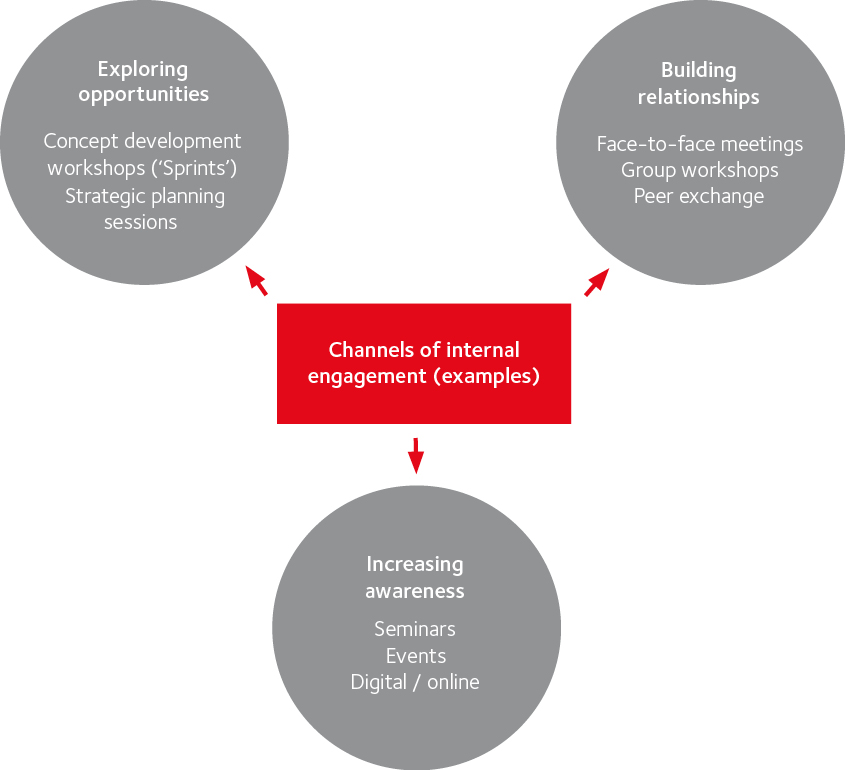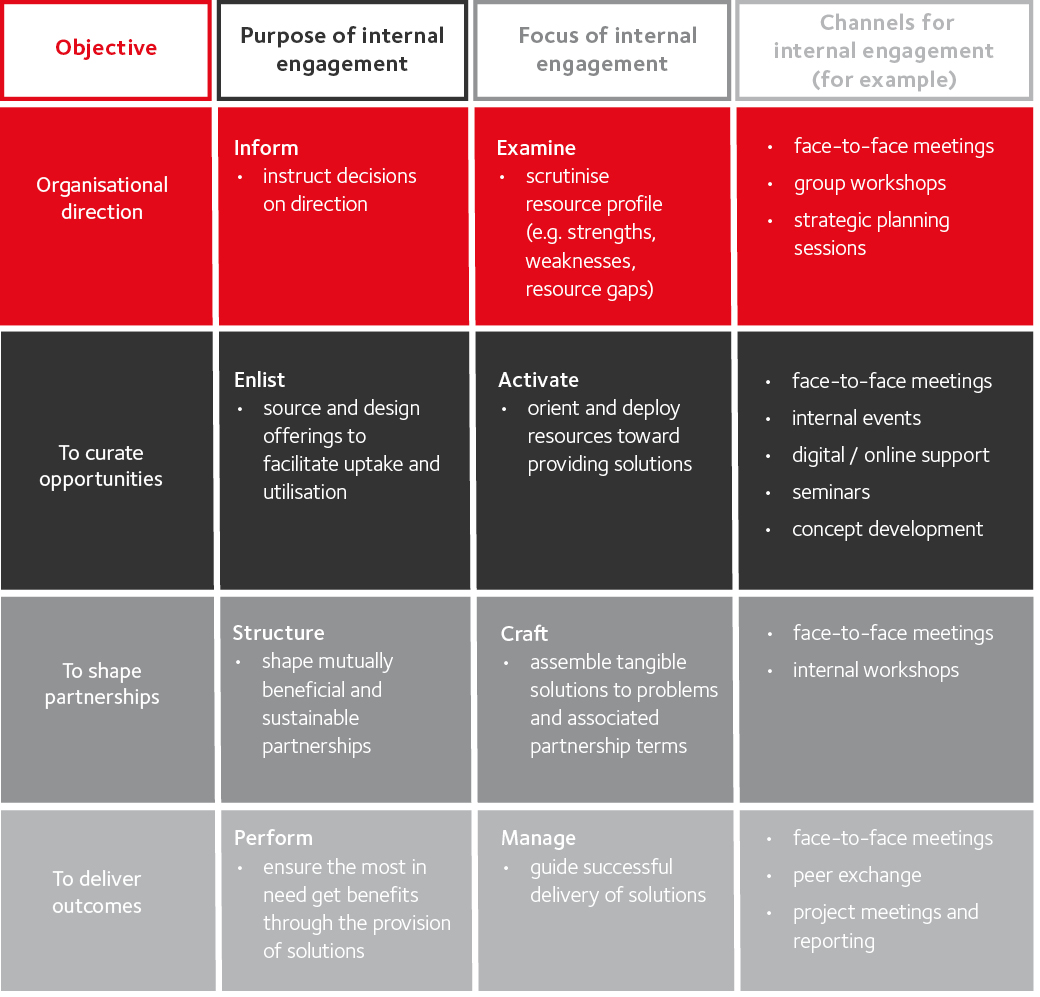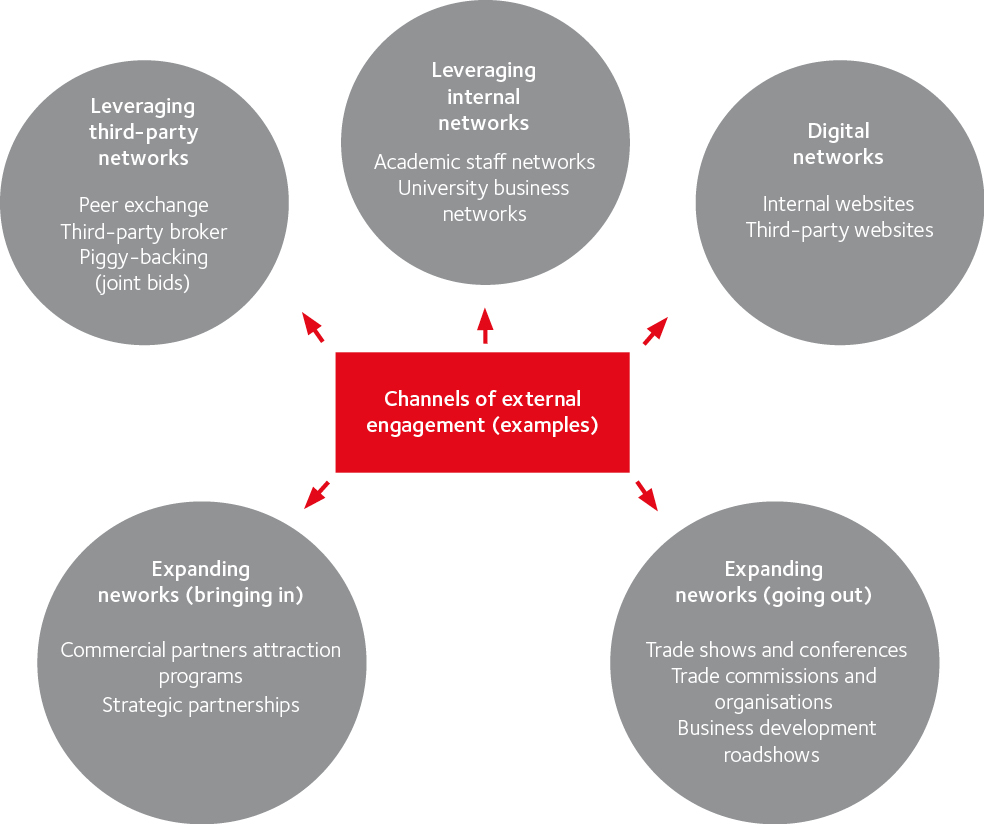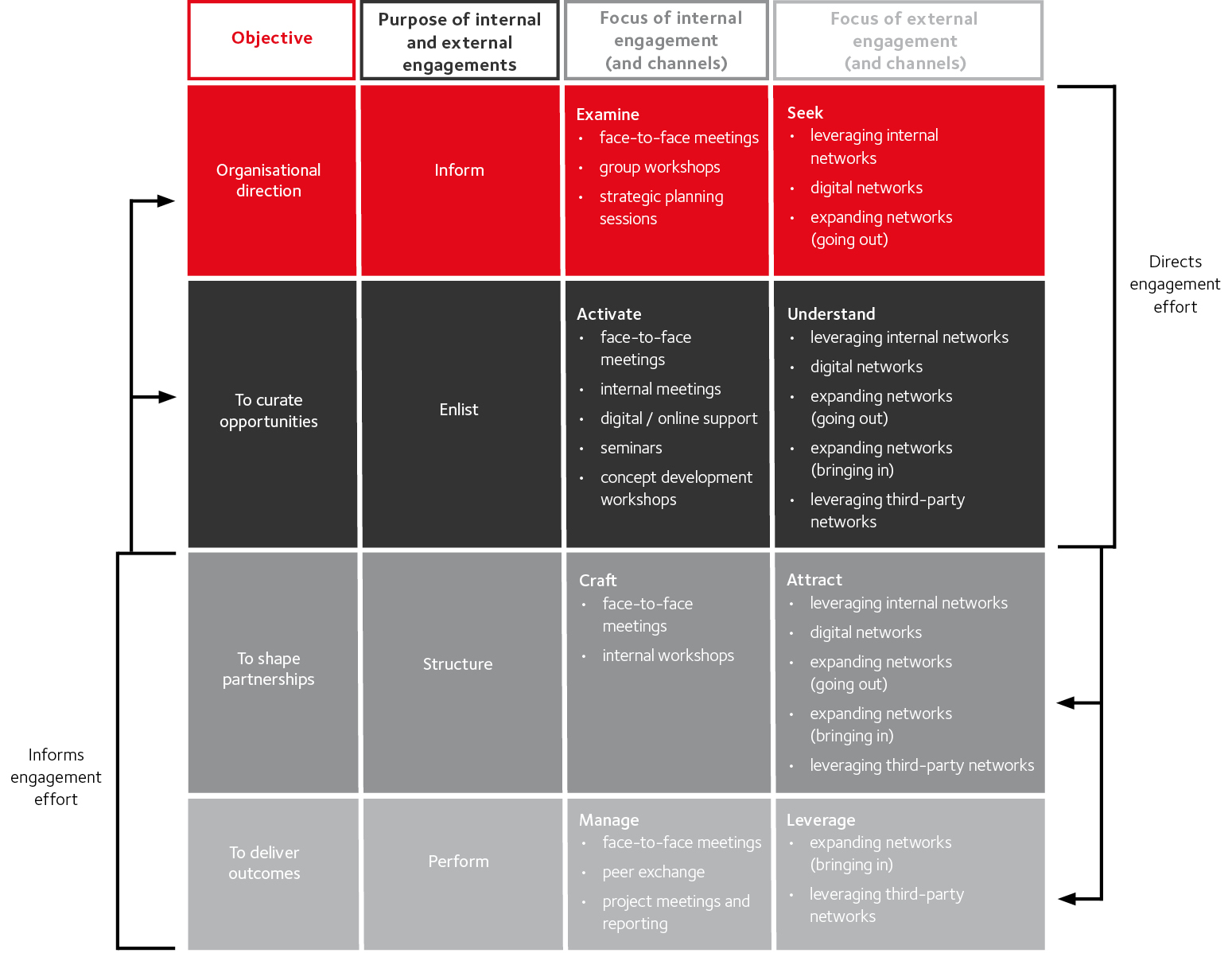This is Section 8 of the series on the topic of deriving impact from universities in the 21st century, authored by Nicholas Mathiou, Director of Griffith Enterprise.

“The old river in its broad reach rested unruffled at the decline of day, after ages of good service done to the race that peopled its banks, spread out in the tranquil dignity of a waterway leading to the uttermost ends of the earth.”
– Joseph Conrad, Heart of Darkness
8. Channels of engagement
Introduction
A university can be described as a complex of diverse programs, products and services that are offered to an array of partners. In such a business context, engagement activities are, without question, a fulcrum for deriving great societal impact from universities. This is especially the case for organisations with defined resource envelopes which face unprecedented challenges of rapid and repeated disruption. Universities must work out ways to identify and attract potential partners with whom they can work to address societal needs. They must shape engagements that benefit universities, their prospective partners and our communities. This process requires sound and informed judgment so the correct opportunities are prioritised and resourced accordingly.
In the previous section of this series we considered the activities through which universities ensure relevant and up-to-date information is always available to guide key decisions. To this end we framed and established the case for ‘purposeful engagement’ – focusing internal and external engagement activities around key University objectives and therefore the purposes for engagement. In this section we give important thought to the support mechanisms for these engagement activities which can only be brought about through suitable avenues. These are the lines of connection, always live, always open, within the university complex; the myriad tributaries that support the flow of valuable information and expert knowledge as they reach past university perimeters to catchments beyond.
In effect, these are the channels of engagement utilised by universities to enable the internal and external engagement. In most cases, these channels will be recognisable and familiar, but considered thought about how they function in this university and how they serve university objectives is warranted here. We start with an examination of internal engagement channels.
Internal Engagement Channels
The channels for internal engagement can be extensive, and include face-to-face meetings, group workshops, and peer exchange programs (collectively utilised to build relationships); events, seminars and digital/online platforms (often used to increase awareness); and strategic planning sessions and concept development workshops (applied to explore opportunities).
In nearly all instances face-to-face meetings involving academic staff are key to success. Academic staff possess high-quality knowledge of their fields of endeavour. They are a cornerstone of the offering process and competitive offerings often involve teams of academic staff drawn from broad fields of endeavour. As educators, research experts or creators of IP, university staff provide the solutions sought by partners and collaborators. They are integral to delivering solutions and together with partners, socio-economic benefits.
This means that building internal relationships with and between key academic staff is clearly fundamental to success. Therefore, it is incumbent on universities to ensure that various channels are in place to maintain and increase awareness of organisational direction across the entire university and to explore potential solutions to societal or organisational challenges. Those channels that inform academic staff of the various support services and programs available to them are also critical to the curation of opportunities and shaping of enduring partnerships.
Individual meetings may not always be practical to gain the necessary internal reach. In such circumstances, events, seminars and digital/online platforms to present these opportunities are often utilised. On a more structured level, strategic planning sessions and internal concept workshops can be used to explore opportunities to articulate the natures of problems, to shape associated solutions, and to mobilise key stakeholders. Strategic planning sessions can also be a useful platform to plan how best to leverage existing partnerships and relationships.
Key examples of the various channels of internal engagement are presented in the diagram below.

In section 7 of this series, we focused on key university objectives associated with deriving impact. Linked to the objectives were the purposes of engaging and in turn the focus of engagement activities. Drawing on this framework, important channels of internal engagement matched to objectives and purposes of engaging for a university are depicted in the diagram below.

External Engagement Channels
The channels for external engagement too can be extensive, but may be broadly grouped within five main categories: (1) Leveraging Internal Networks; (2) Leveraging Third-Party Networks; (3) Digital Networks; (4) Expanding Networks (going-out); and (5) Expanding Networks (bringing-in).
Experienced academic staff are always a good starting point for external engagement. Many are active within industry and government networks, forged through the delivery of programs, products and services that create value. These are internal networks that can be leveraged by a university for external engagement.
In the same vein, external networks can be leveraged, for example, by partnering with large national or international organisations that regularly win projects, by participating in peer exchange programs, or by utilising specialist business brokers (particularly useful when engaging in international markets).
Digital networks, both internal and third-party platforms, offer an efficient way to showcase university resources, with targeted social media campaigns that drive traffic often a key to the success.
On the ground, rather than online, networks can also be expanded by going-out (e.g. business development roadshows, tradeshows and trade commissions) and by bringing-in (e.g. hosting key industry partners on campus or establishing Industry Advisory Boards). The channels of engagement, therefore, must be varied in their formation and function.
Key examples of the various channels of external engagement are presented in the diagram below.

Drawing again on the framework presented in section 7 of this series, important channels of external engagement matched to key university objectives, and associated purposes of engagement and focuses of engagement activities are depicted in the diagram below.

Prioritising Engagement Activities
Both internal and external engagement activities are fundamental to deriving impact from universities. Equally clear is that universities cannot be everything to everyone. Accordingly, the discussion moves forward to the process of informing, positioning and prioritising opportunities. This involves combining clarity of purpose for engagement activities with, first, the Nature of Opportunity and, secondly, the Operational Segments.
In the case of the former we revisit section 5 of this series where we explored how a university can discern its ‘opportunity spectrum’ – essentially the process of matching university strengths to opportunities. Informed by a university’s opportunity spectrum, a university gains an understanding of the Nature of Opportunity, allowing proactive engagement activities which can then be directed toward those opportunities and partnerships that are likely to yield the most socio-economic impact.
In the case of the latter, also discussed in section 5, we retrace how the diversity of activities at any university necessitates different approaches and resourcing. There are two major Operational Segments, the first made up by the relatively small number of engagements that are associated with the majority of the cumulative revenue. This operational segment involves a proactive approach, significant internal and external engagement activities, and longer-term resourcing and investment to position opportunities for expansion and success. For this operational segment, the full gamut of internal and external engagement channels is utilised. Long-standing relationships with third-parties are a hallmark of this segment, along with multiple touch points across organisations and the provision of multiple offerings and therefore requires customer relationship management approaches.
The second operational segment involves the majority of engagements that are associated with a relatively small proportion of cumulative revenue. The diversity of engagements in this operational segment necessitates different approaches to, and resourcing of, associated activities. Relationships typically exist between individual university staff and third parties, and involve the provision of a single line of service or product. This segment requires efficient and effective support, streamlined processes and should absorb much less resourcing and investment. With suitable channels in place, a university can be well positioned to efficiently manage the business offering within this segment.
Orientation of Engagement
From the discussion above, it will be evident that some aspects of purposeful engagement laid out in section 7 (‘Purposeful Engagement’) of the series have a strategic orientation and others a more operational orientation.
Engagement activities with a strategic orientation, such as determining organisational direction and curating opportunities, help direct engagement efforts with an operational orientation.
Engagement activities with an operational orientation, such as shaping enduring partnerships and delivering benefits, help inform organisational direction and future engagement efforts.
This continual ‘directing’ and ‘informing’, presented in the framework below, demonstrates the inherently iterative nature of this process and the inextricable yet ever-evolving links between the various activities.

However, while the outcomes from purposeful engagement will differ, the approach to purposeful engagement remains the same, guided by an ‘objective’ which is constant. This is all galvanised by a university’s ability to direct and inform engagement activity in a coordinated manner through strategic communication, facilitated by the selection and use of appropriate channels of engagement.
Optimising Engagement Channels
Through channels of engagement universities strive to ensure that important information about the expertise and resources within a university is live and consistent, while also enhancing knowledge of external environments and associated opportunities. These channels, when strategically set in place by universities, support and enable purposeful engagement. Continually considering the following three questions helps universities keep relevant and supportive channels in place:
Question 1: Are our engagement activities aligned with the opportunities most likely to derive significant impact?
Question 2: What channels best serve our purposeful internal engagement activities?
Question 3: What channels best serve our purposeful external engagement activities?
Armed with a framework that enhances purposeful engagement and the utilisation of the appropriate channels for engagement, we move next to designing an operating model that can support the achievement of universities’ organisational directions.
Read the previous article from this series.

ABOUT THE AUTHOR: Nicholas Mathiou is Director of Griffith Enterprise, the innovation and enterprise office of Griffith University. He has extensive commercial experience, having established and grown innovation-based businesses and organisations. He is driven by an ambition to see great social dividends emerge through university-based innovation. He has a deep understanding of the unique challenges involved in advancing innovations within complex organisations and in dynamic environments.
Introduction image credit: photo by Thomas Somme on Unsplash


